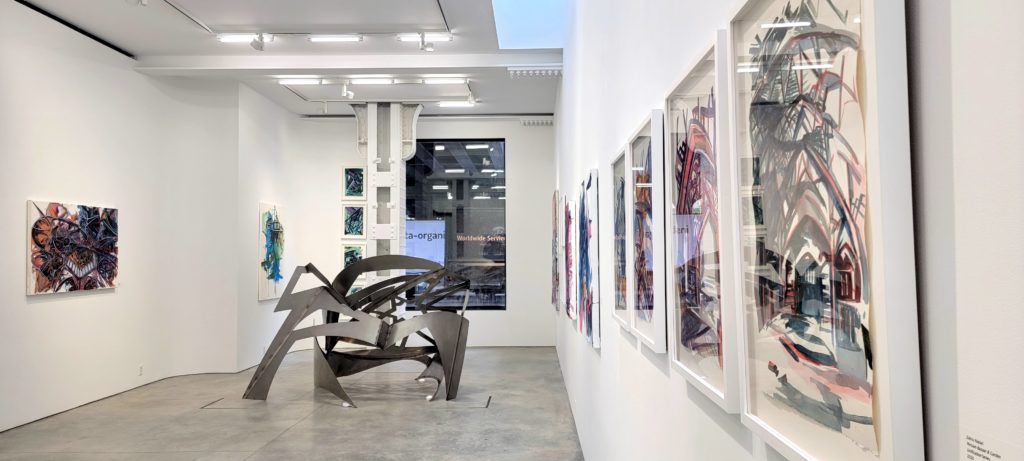
The foundation of my work is based on architectural references from my memory of my homeland of Iran and my life as an immigrant in NYC. The experiences I had visiting archaeological sites throughout Iran continue to inspire and inform my work. Since my migration to the United States, my work has evolved into a formal blending of Persian and Western architectural styles, specifically European futurism. As my approach has developed, the color palette of my paintings has progressively grown from dark and intimist tones to more colorful expressions enlivened by energetic brush strokes. These changes reflect, in part, my perspective as an immigrant New Yorker, and echo the speed, technology, and industrial landscapes of contemporary urban life – the very elements I admire in post-modern futurism.
Zahra Nazari (b. 1985) is a New York City-based painter, sculptor, and installation artist who focuses on architectural themes in multicultural contexts.
Born to a family of architecture enthusiasts in Hamedan, Iran, Nazari has built her career as a visual artist on the foundation of memories from her youth. She is deeply influenced by ancient Persian art and architecture and the landscapes in which they have historically blossomed.
One of her most recent projects, “Unification,” was a 12-gauge stainless steel sculpture that was exhibited at the High Line Nine Gallery and in the Sculpture Space Garden. The work reimagines modern Persian architecture within a Western, futurist context. The hard work of sculpting steel – a key ingredient in Europe’s industrialization – mirrors the conceptual labor of uniting disparate cultures into a single element, and reminds us of the urgent need for diverse perspectives and dialogue.
Nazari has discussed these themes and others in artist talks and on panels at a variety of institutions, including NYU, Columbia University, Cooper Union, and Pratt Institute in New York City. Her work has been reviewed and published in Artefuse, Hamptons Art Hub, Hyperallergic, Whitehot Magazine, ZH Magazine, and more.
Nazari’s work is found in private and public collections around the world, and she exhibits widely. Among other venues, Nazari’s work has been featured in shows at The Bronx Museum of the Art (New York); Samuel Dorsky Museum of Art (New Paltz, NY); Hollis Taggart Gallery, (New York); High Line Nine Gallery (New York); MANA Contemporary (Jersey City, NJ); Spartanburg Art Museum (Spartanburg, South Carolina), Masur Museum of Art (Monroe, LA); New York Academy of Art (New York); Denise Bibro Fine Art (New York); Illinois Institute of Art (Chicago); China Millennium Monument (Beijing, China); Lite-Haus Galerie (Berlin, Germany); Saba Institution (Tehran, Iran); and Baran Gallery (Tehran, Iran).
Nazari has also received a number of prestigious grants and fellowships, including a Creative Engagement Grant from the Lower Manhattan Cultural Council (New York); FST Studio Projects Fund (New York); the AIM Fellowship from the Bronx Museum (New York); a Visiting Artist Fellowship from MASS MoCA (North Adams, Massachusetts) and Cooper Union (New York). She has been an artist in residence at Sculpture Space (Utica, NY), and the Vermont Studio Center (Johnson, VT), among several others.
Nazari received her BFA from the School of Art & Architecture in Tabriz, Iran, and her MFA from the State University of New York in New Paltz in 2014.
….
“Working from both photographs and memory, while allowing for improvisation and invention, Nazari rarely renders whole buildings in her paintings. Instead, she paints excerpts especially significant for her—a section of ceiling with its elaborate details, a particular sequence of windows or vaults, floral patterning, part of a wall—which she combines with abstract gestures and shapes, other forms resembling jumbled architectural fragments, and intermingling colors. Architecture is never static in these works, but instead unstable, changeable, often vertiginous, and under duress (the Ali Qapu Palace, incidentally, ravaged by environmental and political forces, was at one point a ransacked ruin). Construction and deconstruction share close quarters in Nazari’s work.
Many of Nazari’s abstract forms, or what Western viewers might normally think of as abstract forms, including prominent angles, jutting bands, arcs, cross-hatching, rudimentary geometric shapes, and irregular color blocks, derive more from Persian architecture than Western abstract painting. Domes, vaults, honeycombed muqarnas, arabesques, eight-pointed stars, latices, and minarets—all of these, however, transformed, are recurring motifs. Also fascinating to note is that the colors in Nazari’s distinctive palate, including various purples, soft reds, golds, tawny browns, oranges, and rich blues, are especially important and meaningful in Persian architecture, and have been for centuries.
Nazari often combines multiple views of the same building, or a portion of that building, in a single painting, in a way that scrambles and shifts the viewer’s perspective; very often one is not at all sure whether one is looking up or down, at something distant or close—visual manifestations of cultural and personal disorientation. In Nazari’s Sheikh Lotfallah Mosque (2020), you look at this structure, or portions of it, from afar, but simultaneously from within it; at parts of its façade from a distance but also from inside at sections of its interior ceiling(s). With rich blue, gold, red, and purple tones, this vivid, composite scene is also curiously vaporous, like a slippery memory or a receding dream—an effect augmented by how Nazari has left large portions of the painting bright white.”
Gregory Volk, catalog essay for Unification, Zahra Nazari solo exhibition at High Line Nine Gallery, NYC, 2021.



